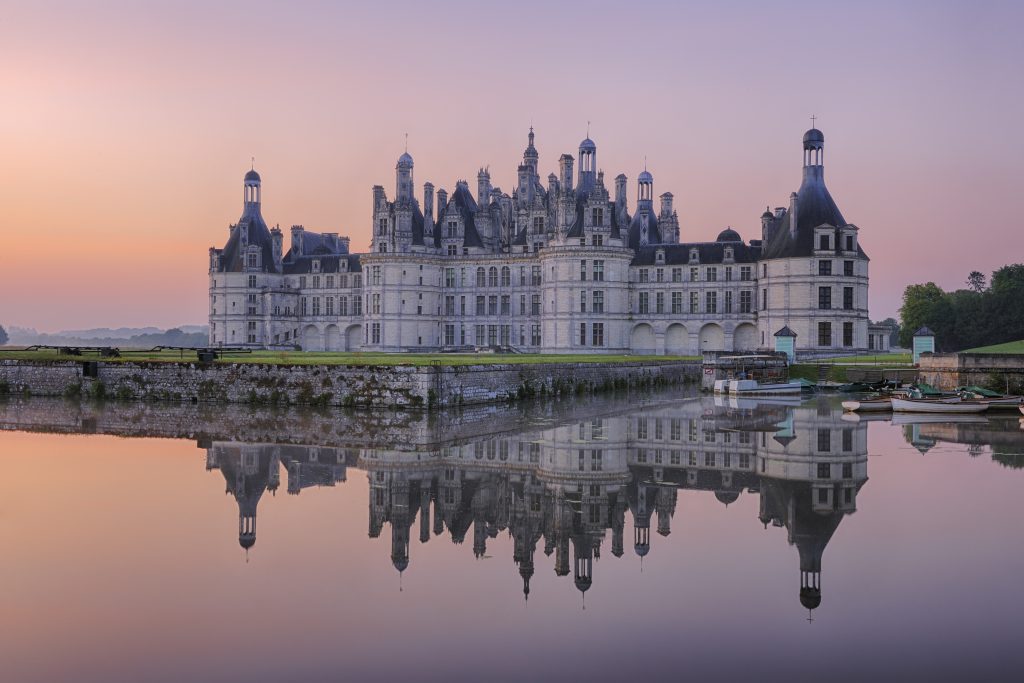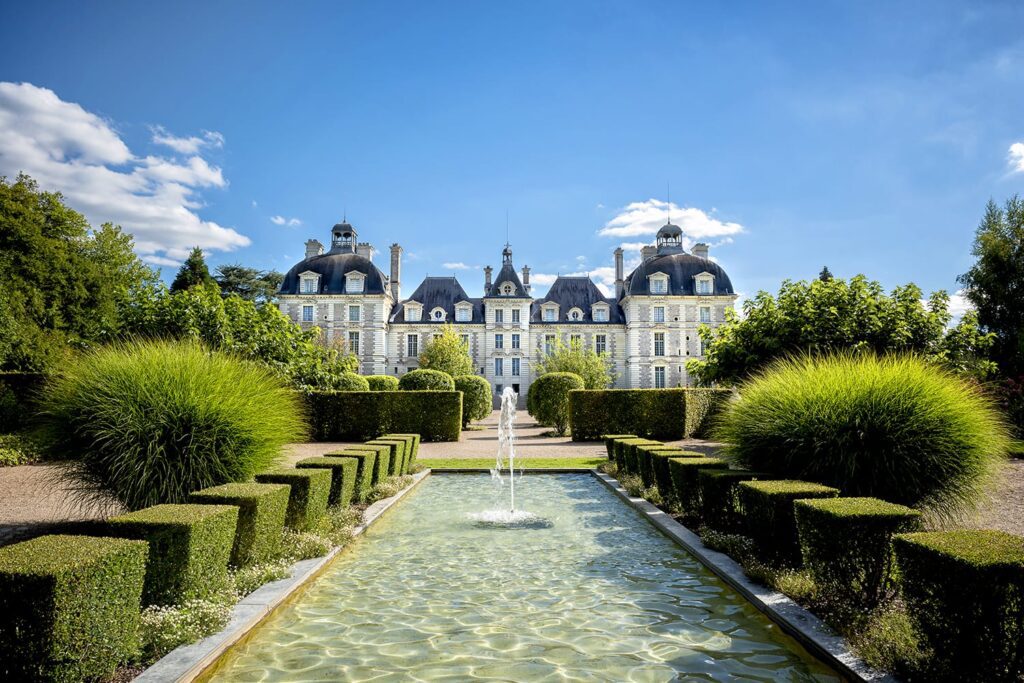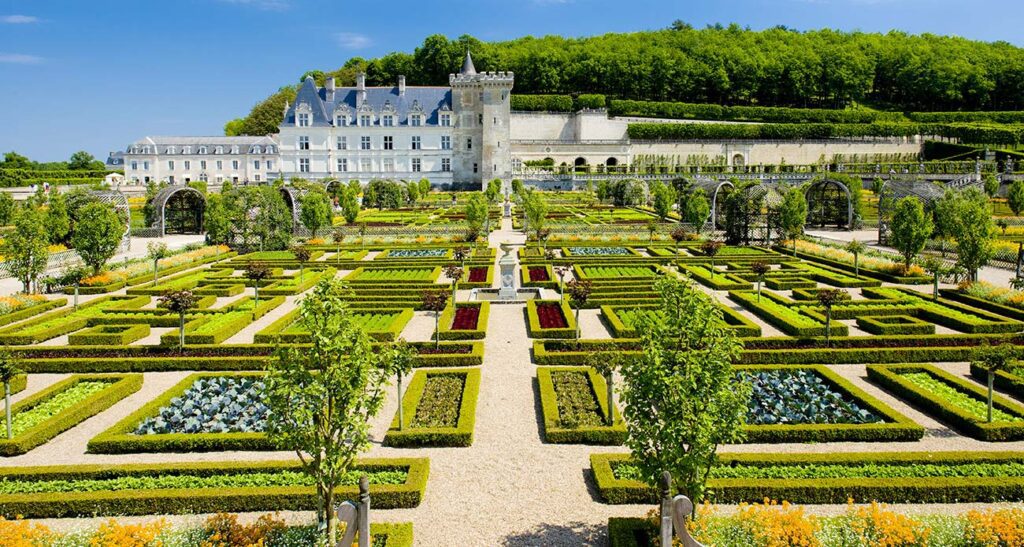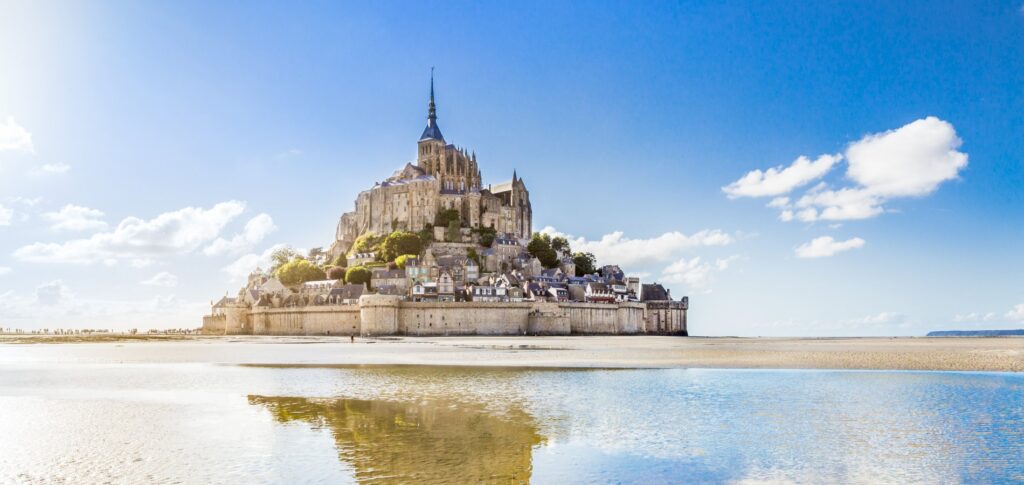Châteaux Of The Loire Valley Travel Guide
Introduction
Short Background
At the end of the Middle Ages, France changed. The Medieval period was a time of wars and conflicts when France was more minor than today. Areas of France had been fought over, notably between the French and the English (who were still French at the time), the French and the Burgundians, and other powers to the south and the east. Medieval castles needed fortresses, defensive positions in strategic locations, or bastions built to affirm the power of a local duke or baron. The massive royal fortress at Angers is a fine example of this. In the year 1475, the Hundred Years’ War with England came officially to an end. Two years later, on the death of Duke Charles, the Bold at the battle of Nancy, King Louis XI took over Burgundy and Picardy and reestablished the power of the King of France over most of the area we know today as France. An era of relative peace was ushered in.

This coincided with the arrival in France of the Renaissance. This artistic and cultural movement had begun in Italy a hundred years before. As the ideas of medieval and feudal society died out, dukes, princes, and kings began to convert old castles and build new ones not designed for war but for peace. The 16th-century châteaux, for which the Loire is justly famous, were constructed as Renaissance palaces where their owners could enjoy the good life and partake in their favorite sports, notably hunting in the forests of the Loire valley. The first of the Renaissance Loire Chateaux is said to be the Ducal Palace at Nevers (Burgundy), built between 1470 and 1490 to replace an earlier fortified castle, but the building of the greatest Loire Chateaux took place between 1490 and 1550. The most intense period of activity was during the 20 years between 1514 and 1534; the Chateau de Chenonceau was started in 1514, a year before King François 1 began renovating the château de Blois. The château at Azay-le-Rideau was started in 1518, the Château de Chambord in the following year, 1519, and the Château de Valançay the year after. The château de Villandry was begun 12 years after that. More châteaux were built or rebuilt over the ensuing century, giving the Loire Valley area an exceptional heritage of Renaissance palaces, recognized today as a UNESCO World Heritage site.
Location

Spread across 280km between Sully-sur-Loire and Chalonnes-sur-Loire, the idyllic Loire Valley, or La Loire, is an often-overlooked region of France just one hour and thirty minutes from Paris. With bustling cities and charming small towns alike—along with an extensive network of cycling and hiking trails, world-famous vineyards, expansive gardens, and majestic châteaux—the “Garden of France,” as the region is affectionately called, merits more than a day trip.
Châteaux Of the Loire Valley
Château de Chambord

Arguably the most iconic of the Loire Valley châteaux, Chambord was commissioned by Francis I (François I) as a symbol of the far-reaching magnitude of his power. Having just returned from Italy after this 25th birthday, Francis I was influenced by the Renaissance style, touches of which can be found throughout the castle—most notably in the famous double helix staircase. The castle was still not completed after the king’s death in 1547. His son, Henry II, continued the work until his untimely death during a jousting tournament in July 1559. Religious wars followed when the castle was left in disarray, only to be finished almost a century later by Louis XIV (aka the “Sun King”). The 157-meter-long by 114-meter-wide monstrosity—designed as a hunting lodge and only inhabited for a handful of holidays—encapsulates the transition between the Middle Ages and the Renaissance. It’s surrounded by the largest enclosed forest park in Europe, housing over 800 stag and deer and 1500 wild boar. Chambord by the numbers: 440 rooms, 73 staircases, 365 windows, 300+ salamanders painted on the walls (Francis I’s emblem)
Château de Chenonceau

As you approach Chenonceau via the long driveway, the castle peaks through the foliage, meadows, and vineyards—a dramatic entrance fitting its dramatic history. It’s known as the “Ladies’ Château” due to the generations of women that have influenced its architecture, design, and subsequent redesigns. Thomas Bohier, who worked as the Secretary General of Finance for King Francis I, purchased the land on February 8, 1513. However, with a demanding work schedule, he left his wife, Katherine Briçonnet, in charge of the construction, which lasted just seven years. It then came into the hands of Diane de Poitiers, King Henry II’s mistress. She embarked on an ambitious refurbishment, including a Cher River bridge. Upon the king’s death, his wife, Catherine de’ Medici, ousted her late husband’s mistress and redecorated the rooms once again to remove any evidence of Diane. Catherine bequeathed the castle to Louise of Lorraine, who became a recluse within its walls when her husband was killed, although its sad character didn’t last long. Spared from destruction during the French Revolution, Chenonceau became the site of a vibrant literary fair during the Age of Enlightenment, only to be purchased in 1863 by Marguerite Pelouze, who went bankrupt renovating the castle. Five arches support the famous two-level gallery with corbelled turrets. Taking a cue from the architectural style of Venetian palaces, Chenonceau is built with a central hall, angular staircase, and rooms laid out on either side–unique features for the period. Numerous immaculately designed gardens dot the castle grounds, the most popular of which are the Diane de Poitiers Garden and the Catherine de’ Medici Garden. There’s also an Italian maze designed by de’ Medici, which contains over 2,000 yew trees surrounding a central gazebo.
Château d’Amboise

It dates back to the 11th century, although its original medieval edifice was renovated into an imposing Gothic masterpiece at the hands of Charles VIII, who was born in Amboise and, upon assuming control in 1483, brought over Italian artists to re-decorate the castle in a Renaissance style. Louis VII maintained this early French Renaissance style as he continued the work of his predecessor. The castle reached the pinnacle of its glory during the reign of Francis I (who spent his childhood there). Awed by the mastery of Leonardo da Vinci, Francis I invited him to France to work on dedicated pieces for the castle. Da Vinci lived in the nearby Clos Lucé, connected to Amboise via an underground passage. Upon his death in 1519, da Vinci was buried in the Saint-Hubert chapel of Amboise. Henry II (the son of Francis I) and his wife, Catherine de’ Medici, raised their children at Amboise before they were forced out due to the ensuing religious wars. After the French Revolution, Napoleon ceded the castle to the politician Pierre-Roger Ducos, who demolished the majority of the original structure. Since then, there has been a gradual restoration effort to restore the castle’s balconies, roofs, and terraced gardens to their original splendor.
Château de Cheverny

Cheverny is a striking example of the French classical style that blossomed during the reign of Louis XIV and is characterized by symmetry and simplicity. Built by architect Jacques Bougier between 1620 and 1640, it is marked by a central building flanked by two residential wings. The same family has owned Cheverny for over six centuries and, for this reason, was remarkably unaffected by the Renaissance. It hasn’t been modified since the 17th century—the original architectural design, complete with coffered ceilings, is still intact and cared for by the current Hurault generation, Marquis and Marquise of Vibraye. Today, it’s celebrated as much for its rich history and architectural grandeur as its modern cultural appeal. It inspired the famous Belgian cartoonist Hergé as he wrote The Adventures of Tintin, one of the most renowned European comics of the 20th century. Today, a permanent 3D exhibit is dedicated to Captain Haddock and Tintin. Expansive lawns and an English-style park surround the château dotted with soaring redwoods, cedars, and lime trees planted between 1820 and 1860. Visitors have the option of touring the grounds by electric boat or car. Also worth noting? The more than 100 Anglo-French dogs (cross between English fox hounds and French Poitevins) live in the kennels of Cheverny.
Château de Villandry

Villandry in Tours was the last of the Loire Valley castles built in the Renaissance style—all due to Jean Le Breton, the Finance Minister to Francis I, who demolished the original fortress to construct the opulent château in 1532. It remained within the same family until 1754 when the Marquis de Castellane became the owner and decided to modernize it in the Neoclassical style, which was very much so à la mode during the 18th century. In the early 20th century, it was purchased by a young Spanish doctor, Joachim Carvallo, and his wife, Ann Coleman, heir to an American iron and steel empire. The current owner, Henri Carvallo, is Joachim and Ann’s great-grandson. Locals and travelers flock to Villandry for its six renowned formal French gardens, all designed by theme. There’s an expansive vegetable garden which, from an aerial viewpoint, looks like a checkerboard of different-colored squares; a Water Garden surrounding a tranquil pond; an Ornamental Garden dedicated to the theme of music (harp-shaped bushes included); and more.
Château d’Azay-le-Rideau

Nestled along the Indre River is the elegant Château d’Azay-le-Rideau, whose exterior is reflected in the stunning water mirror below. Construction began in the late 15th century when Martin Berthelot purchased the land for his son, Gilles. Far too occupied with work obligations to take on the project, Gilles left it to his wife, Philippe Lesbahy. Under her direction, French architectural styles were fused with artistic influences from the Italian Renaissance. Although spiral staircases were standard then, the château departed from tradition with an innovative angular staircase still on display today. Despite Philippe’s efforts to remain Azay-le-Rideau’s owner, she and her husband, accused of embezzlement, were eventually forced out as the château fell into the hands of Antoine Raffin, Captain of the Guard under Francis I. It remained in his family until the French Revolution when it was ultimately purchased by Charles de Biencourt and restored by generations of his family over the following century—except the landscaped park, which retained its 19th-century English-style garden design. The property was eventually purchased by the State in 1905 and classified as a monument historique nine years later. Extensive restoration work has been underway since 2013.
Château de Blois

Composed of four wings surrounding a courtyard, Château de Blois is a sprawling testament to five centuries of French architectural style from the 13th to the 17th. No shortage of drama has ensued within its walls, from love stories to betrayals, assassinations to reconciliations. It was here where, in 1429, Joan of Arc went to be blessed by the Archbishop of Reims before departing on her quest to drive the English from the city of Orléans. Charles d’Orléans decided to make Blois his home after 25 years of imprisonment in England. His son, Louis XII, was born here and, upon assuming the throne in 1498, designated Blois as the kingdom’s capital. Francis I spent time here, as did Henry III, who ordered the assassination of the Duke of Guise to take place in the castle. King Louis XIII, fed up with the political meddling of his mother, Marie d’Medici, exiled her to Blois (she escaped) before he gifted it to his brother, Gaston d’Orléans. Architecturally, the château is celebrated for its late-Gothic, early-French Renaissance style inspired by that of the Vatican—spiral staircase included. Don’t miss the Musée des Beaux-Arts, the apartments that Louis XII lived in with Anne of Brittany. If you visit during the summer, you may catch one of the spectacular sounds and light shows when the castle’s facade is transformed into a giant screen.
Château d’Ussé

Château d’Ussé is straight out of a fairy tale. With turrets, bell towers, spires, and soaring chimneys, it inspired Charles Perrault’s Sleeping Beauty. Although originally constructed in the Middle Ages as a Medieval fortress lining the forests of Chinon (drawbridge and moat included), it was renovated over time into a residential Renaissance château that housed notable figures such as the writer François-René de Chateaubriand. Today, Ussé is owned by the Duke of Blacas.
Château d’Angers

Construction on Château d’Angers began as early as 1230, with limestone and slate used to build the imposing structure overlooking the Maine River. As the largest castle fortress in France, it was occupied by the Counts of Anjou and stood as a testament to the power of their enduring political dynasty—with the Dukes of Anjou holding court in the 14th and 15th centuries. One of its biggest draws today is the Tapestry of the Apocalypse, which was commissioned in 1375 by Louis I. Measuring 140 meters long (of which 100 meters are currently preserved and on display), the tapestry depicts the apocalyptic story in front of the Book of Revelation by Saint John. The timing of its creation in the late 14th century is worth noting, as it corresponds with the Hundred Years’ War between France and England. The surrounding grounds feature sprawling gardens, including a vegetable garden, rose garden, and hydrangea garden. There’s also a unique hanging garden with medicinal and tincture plants.
Château de Chinon

This Neolithic-turned-Gallic-turned-Roman fort-turned-medieval fortress perched above the Vienne River boasts a long, contentious history between the French and the British. The King of England, Henry II, made Chinon his home when he married the former Queen of France, Eleanor of Aquitaine (after her divorce from Louis VII). It all went downhill when Henry’s son Richard “Lionheart” declared war on him. Henry II died at Chinon in 1189. While dramatic, it pales in comparison to the marquee historical event at Chinon: the meeting between Joan of Arc and Charles VII during the Hundred Years War when she persuaded Charles to defend himself against the English and reclaim his rightful throne. Travelers worldwide also flock to Chinon because of its link to the Knights Templar. It’s here where, according to legend, the Grand Masters of the order were imprisoned before being put to death in Paris at the Vatican’s order in 1308.
A Private Tour to The Loire and Normandy
This northern France tour is the perfect way for value-minded travelers to see the Loire Valley and Normandy highlights. Set off on a journey of discovery and explore France’s top destinations on this six-day tour. With an experienced guide-interpreter from our team, you will start by examining the most famous Châteaux of the Loire Valley, then head north to visit Saint-Malo in Brittany and Mont Saint-Michel. Then, browse Normandy with the towns of Rouen and Honfleur and a D-Day Landing Beaches tour. Beautiful scenery, famous landmarks, and fascinating history summarize this 6-day private tour.

Skip-the-line-tickets
Best hotels in the Loire Valley
Chateau De La Barre: Château de la Barre, the beautiful home of the Vanssay family since 1404, is an exclusive Château offering tailor-made vacations in the most authentic tradition of French aristocracy. It is located less than 2 hours from Paris at the beginning of the Loire Valley, with its famous castles.
Château D’artigny: Chateau d’Artigny is the dream Belle Époque castle built by François Coty, the famous perfumer. This Castle-hotel is located in the heart of the Loire Valley, just 15 km from Tours, and dominates the valley.
Château De La Bourdaisière: This castle, located in the heart of the Loire valley, promises a new lifestyle and a school of nature. It revives the spirit and comfort of the great houses of the past centuries.
La Maison Troisgros: La Maison Troisgros is a Michelin Guide three-starred restaurant in Roanne, France, northwest of the city of Lyon. Head chef Michel Troisgros of the Troisgros family runs the hotel/restaurant with his wife, Marie-Pierre. In 1930, Burgundy native Jean-Baptiste Troisgros moved to Roanne with his wife, Marie, and bought a small hotel. She did the cooking; he oversaw the house. This was the beginning of a 3-generation dynasty of gastronomy that has seen La Maison Troisgros celebrate more than 30 consecutive years with three Michelin stars.










